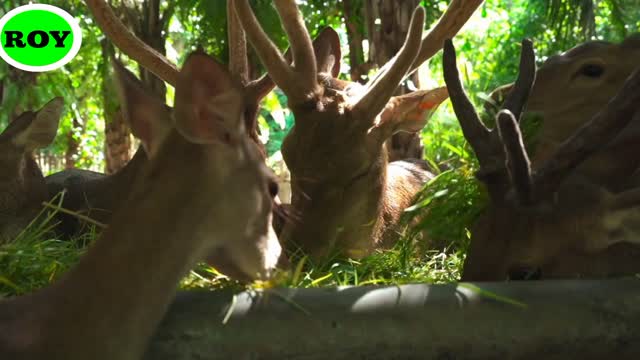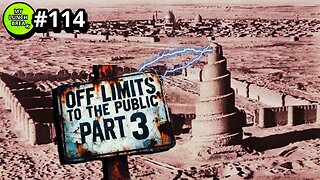Premium Only Content

Watch videos of deer of different colors.
Deer or true deer are hoofed ruminant mammals forming the family Cervidae. The two main groups of deer are the Cervinae, including the muntjac, the elk (wapiti), the red deer, and the fallow deer; and the Capreolinae, including the reindeer (caribou), white-tailed deer, the roe deer, and the moose. Male deer of all species (except the water deer) as well as female reindeer, grow and shed new antlers each year. In this they differ from permanently horned antelope, which are part of a different family (Bovidae) within the same order of even-toed ungulates (Artiodactyla).
The musk deer (Moschidae) of Asia and chevrotains (Tragulidae) of tropical African and Asian forests are separate families that are also in the ruminant clade Ruminantia; they are not especially closely related to Cervidae.
Deer appear in art from Paleolithic cave paintings onwards, and they have played a role in mythology, religion, and literature throughout history, as well as in heraldry, such as red deer that appear in the coat of arms of Åland.[2] Their economic importance includes the use of their meat as venison, their skins as soft, strong buckskin, and their antlers as handles for knives. Deer hunting has been a popular activity since the Middle Ages and remains a resource for many families today.
The word deer was originally broad in meaning, becoming more specific with time. Old English dēor and Middle English der meant a wild animal of any kind. Cognates of Old English dēor in other dead Germanic languages have the general sense of animal, such as Old High German tior, Old Norse djur or dȳr, Gothic dius, Old Saxon dier, and Old Frisian diar.[3] This general sense gave way to the modern English sense by the end of the Middle English period, around 1500. All modern Germanic languages save English and Scots retain the more general sense: for example, German Tier and Norwegian dyr mean animal.[4]
For many types of deer in modern English usage, the male is a buck and the female a doe, but the terms vary with dialect, and according to the size of the species. The male red deer is a stag, while for other large species the male is a bull, the female a cow, as in cattle. In older usage, the male of any species is a hart, especially if over five years old, and the female is a hind, especially if three or more years old.[5] The young of small species is a fawn and of large species a calf; a very small young may be a kid. A castrated male is a havier.[6] A group of any species is a herd. The adjective of relation is cervine; like the family name Cervidae, this is from Latin: cervus, meaning stag or deer.
Deer live in a variety of biomes, ranging from tundra to the tropical rainforest. While often associated with forests, many deer are ecotone species that live in transitional areas between forests and thickets (for cover) and prairie and savanna (open space). The majority of large deer species inhabit temperate mixed deciduous forest, mountain mixed coniferous forest, tropical seasonal/dry forest, and savanna habitats around the world. Clearing open areas within forests to some extent may actually benefit deer populations by exposing the understory and allowing the types of grasses, weeds, and herbs to grow that deer like to eat. Access to adjacent croplands may also benefit deer. Adequate forest or brush cover must still be provided for populations to grow and thrive.
Deer are widely distributed, with indigenous representatives in all continents except Antarctica and Australia, though Africa has only one native deer, the Barbary stag, a subspecies of red deer that is confined to the Atlas Mountains in the northwest of the continent. Another extinct species of deer, Megaceroides algericus, was present in North Africa until 6000 years ago. Fallow deer have been introduced to South Africa. Small species of brocket deer and pudús of Central and South America, and muntjacs of Asia generally occupy dense forests and are less often seen in open spaces, with the possible exception of the Indian muntjac. There are also several species of deer that are highly specialized and live almost exclusively in mountains, grasslands, swamps, and "wet" savannas, or riparian corridors surrounded by deserts. Some deer have a circumpolar distribution in both North America and Eurasia. Examples include the caribou that live in Arctic tundra and taiga (boreal forests) and moose that inhabit taiga and adjacent areas. Huemul deer (taruca and Chilean huemul) of South America's Andes fill the ecological niches of the ibex and wild goat, with the fawns behaving more like goat kids.
The highest concentration of large deer species in temperate North America lies in the Canadian Rocky Mountain and Columbia Mountain regions between Alberta and British Columbia where all five North American deer species (white-tailed deer, mule deer, caribou, elk, and moose) can be found. This region has several clusters of national parks including Mount Revelstoke National Park, Glacier National Park (Canada), Yoho National Park, and Kootenay National Park on the British Columbia side, and Banff National Park, Jasper National Park, and Glacier National Park (U.S.) on the Alberta and Montana sides. Mountain slope habitats vary from moist coniferous/mixed forested habitats to dry subalpine/pine forests with alpine meadows higher up. The foothills and river valleys between the mountain ranges provide a mosaic of cropland and deciduous parklands. The rare woodland caribou have the most restricted range living at higher altitudes in the subalpine meadows and alpine tundra areas of some of the mountain ranges. Elk and mule deer both migrate between the alpine meadows and lower coniferous forests and tend to be most common in this region. Elk also inhabit river valley bottomlands, which they share with White-tailed deer. The White-tailed deer have recently expanded their range within the foothills and river valley bottoms of the Canadian Rockies owing to conversion of land to cropland and the clearing of coniferous forests allowing more deciduous vegetation to grow up the mountain slopes. They also live in the aspen parklands north of Calgary and Edmonton, where they share habitat with the moose. The adjacent Great Plains grassland habitats are left to herds of elk, American bison, and pronghorn.
The Eurasian Continent (including the Indian Subcontinent) boasts the most species of deer in the world, with most species being found in Asia. Europe, in comparison, has lower diversity in plant and animal species. Many national parks and protected reserves in Europe have populations of red deer, roe deer, and fallow deer. These species have long been associated with the continent of Europe, but also inhabit Asia Minor, the Caucasus Mountains, and Northwestern Iran. "European" fallow deer historically lived over much of Europe during the Ice Ages, but afterwards became restricted primarily to the Anatolian Peninsula, in present-day Turkey.
Present-day fallow deer populations in Europe are a result of historic man-made introductions of this species, first to the Mediterranean regions of Europe, then eventually to the rest of Europe. They were initially park animals that later escaped and reestablished themselves in the wild. Historically, Europe's deer species shared their deciduous forest habitat with other herbivores, such as the extinct tarpan (forest horse), extinct aurochs (forest ox), and the endangered wisent (European bison). Good places to see deer in Europe include the Scottish Highlands, the Austrian Alps, the wetlands between Austria, Hungary, and the Czech Republic and some fine National Parks, including Doñana National Park in Spain, the Veluwe in the Netherlands, the Ardennes in Belgium, and Białowieża National Park of Poland. Spain, Eastern Europe, and the Caucasus Mountains still have virgin forest areas that are not only home to sizable deer populations but also for other animals that were once abundant such as the wisent, Eurasian lynx, Iberian lynx, wolves, and brown bears.
The highest concentration of large deer species in temperate Asia occurs in the mixed deciduous forests, mountain coniferous forests, and taiga bordering North Korea, Manchuria (Northeastern China), and the Ussuri Region (Russia). These are among some of the richest deciduous and coniferous forests in the world where one can find Siberian roe deer, sika deer, elk, and moose. Asian caribou occupy the northern fringes of this region along the Sino-Russian border.
Deer such as the sika deer, Thorold's deer, Central Asian red deer, and elk have historically been farmed for their antlers by Han Chinese, Turkic peoples, Tungusic peoples, Mongolians, and Koreans. Like the Sami people of Finland and Scandinavia, the Tungusic peoples, Mongolians, and Turkic peoples of Southern Siberia, Northern Mongolia, and the Ussuri Region have also taken to raising semi-domesticated herds of Asian caribou.
The highest concentration of large deer species in the tropics occurs in Southern Asia in India's Indo-Gangetic Plain Region and Nepal's Terai Region. These fertile plains consist of tropical seasonal moist deciduous, dry deciduous forests, and both dry and wet savannas that are home to chital, hog deer, barasingha, Indian sambar, and Indian muntjac. Grazing species such as the endangered barasingha and very common chital are gregarious and live in large herds. Indian sambar can be gregarious but are usually solitary or live in smaller herds. Hog deer are solitary and have lower densities than Indian muntjac. Deer can be seen in several national parks in India, Nepal, and Sri Lanka of which Kanha National Park, Dudhwa National Park, and Chitwan National Park are most famous. Sri Lanka's Wilpattu National Park and Yala National Park have large herds of Indian sambar and chital. The Indian sambar are more gregarious in Sri Lanka than other parts of their range and tend to form larger herds than elsewhere.
The Chao Praya River Valley of Thailand was once primarily tropical seasonal moist deciduous forest and wet savanna that hosted populations of hog deer, the now-extinct Schomburgk's deer, Eld's deer, Indian sambar, and Indian muntjac. Both the hog deer and Eld's deer are rare, whereas Indian sambar and Indian muntjac thrive in protected national parks, such as Khao Yai. Many of these South Asian and Southeast Asian deer species also share their habitat with other herbivores, such as Asian elephants, the various Asian rhinoceros species, various antelope species (such as nilgai, four-horned antelope, blackbuck, and Indian gazelle in India), and wild oxen (such as wild Asian water buffalo, gaur, banteng, and kouprey). One way that different herbivores can survive together in a given area is for each species to have different food preferences, although there may be some overlap.
Australia has six introduced species of deer that have established sustainable wild populations from acclimatisation society releases in the 19th century. These are the fallow deer, red deer, sambar, hog deer, rusa, and chital. Red deer introduced into New Zealand in 1851 from English and Scottish stock were domesticated in deer farms by the late 1960s and are common farm animals there now. Seven other species of deer were introduced into New Zealand but none are as widespread as red deer.
-
 LIVE
LIVE
The Connect: With Johnny Mitchell
8 hours agoCan He Stop Them? Inside Trumps War On Mexican Drug Cartels & The New Era Of Mexican Organized Crime
362 watching -
 LIVE
LIVE
Tundra Tactical
56 minutes ago $0.04 earnedLuis Valdes Of GOA Joins The Worlds Okayest Firearms Live Stream!!!
423 watching -
 LIVE
LIVE
Man in America
9 hours agoAre Trump & Musk the COUNTER-ELITES? w/ Derrick Broze
1,231 watching -
 LIVE
LIVE
DLDAfterDark
37 minutes agoDLD Live! SHTF Handguns! Which Would You Choose?
256 watching -
 1:50:38
1:50:38
Mally_Mouse
3 hours agoSaturday Shenanigans!! - Let's Play: Mario Party Jamboree
15.4K -
 1:13:00
1:13:00
Patriots With Grit
7 hours agoWill Americans Rise Up? | Jeff Calhoun
8.66K9 -
 14:55
14:55
Exploring With Nug
7 hours ago $5.95 earnedWe Found Semi Truck Containers While Searching for Missing Man!
31K4 -
 27:57
27:57
MYLUNCHBREAK CHANNEL PAGE
15 hours agoOff Limits to the Public - Pt 3
61.9K54 -
 38:07
38:07
Michael Franzese
7 hours agoLeaving Organized Crime and Uncovering Mob in Politics: Tudor Dixon and Michael Franzese
49.5K13 -
 2:42:54
2:42:54
Jewels Jones Live ®
2 days agoAMERICA IS BACK | A Political Rendezvous - Ep. 111
46.2K42